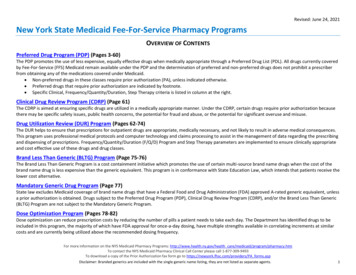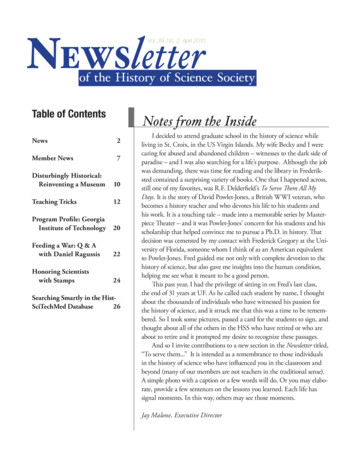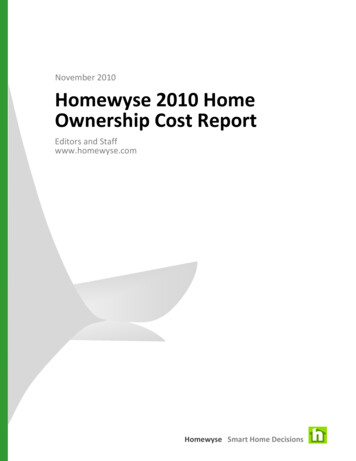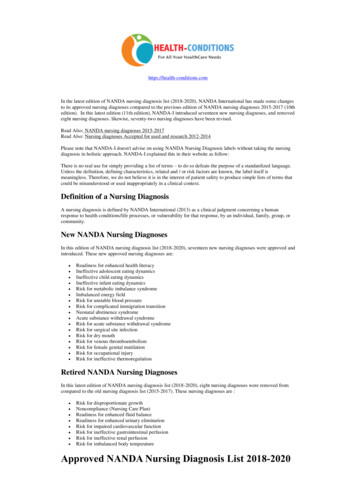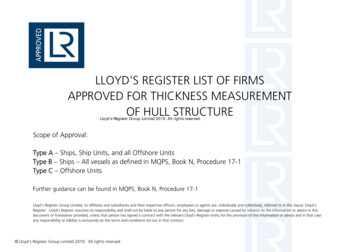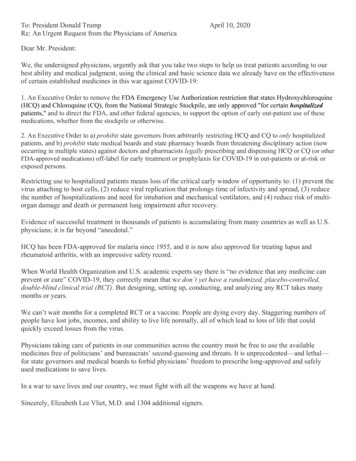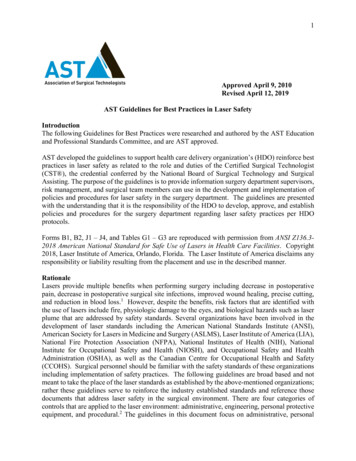
Transcription
1Approved April 9, 2010Revised April 12, 2019AST Guidelines for Best Practices in Laser SafetyIntroductionThe following Guidelines for Best Practices were researched and authored by the AST Educationand Professional Standards Committee, and are AST approved.AST developed the guidelines to support health care delivery organization’s (HDO) reinforce bestpractices in laser safety as related to the role and duties of the Certified Surgical Technologist(CST ), the credential conferred by the National Board of Surgical Technology and SurgicalAssisting. The purpose of the guidelines is to provide information surgery department supervisors,risk management, and surgical team members can use in the development and implementation ofpolicies and procedures for laser safety in the surgery department. The guidelines are presentedwith the understanding that it is the responsibility of the HDO to develop, approve, and establishpolicies and procedures for the surgery department regarding laser safety practices per HDOprotocols.Forms B1, B2, J1 – J4, and Tables G1 – G3 are reproduced with permission from ANSI Z136.32018 American National Standard for Safe Use of Lasers in Health Care Facilities. Copyright2018, Laser Institute of America, Orlando, Florida. The Laser Institute of America disclaims anyresponsibility or liability resulting from the placement and use in the described manner.RationaleLasers provide multiple benefits when performing surgery including decrease in postoperativepain, decrease in postoperative surgical site infections, improved wound healing, precise cutting,and reduction in blood loss.1 However, despite the benefits, risk factors that are identified withthe use of lasers include fire, physiologic damage to the eyes, and biological hazards such as laserplume that are addressed by safety standards. Several organizations have been involved in thedevelopment of laser standards including the American National Standards Institute (ANSI),American Society for Lasers in Medicine and Surgery (ASLMS), Laser Institute of America (LIA),National Fire Protection Association (NFPA), National Institutes of Health (NIH), NationalInstitute for Occupational Safety and Health (NIOSH), and Occupational Safety and HealthAdministration (OSHA), as well as the Canadian Centre for Occupational Health and Safety(CCOHS). Surgical personnel should be familiar with the safety standards of these organizationsincluding implementation of safety practices. The following guidelines are broad based and notmeant to take the place of the laser standards as established by the above-mentioned organizations;rather these guidelines serve to reinforce the industry established standards and reference thosedocuments that address laser safety in the surgical environment. There are four categories ofcontrols that are applied to the laser environment: administrative, engineering, personal protectiveequipment, and procedural.2 The guidelines in this document focus on administrative, personal
2protective equipment, and procedural controls. It is recommended that HDOs have a copy of thefollowing two defining documents for the safe use of lasers available in all areas and departmentsof the facility where lasers are used: ANSI American National Standard for Safe Use of Lasers inHealth Care Facilities and OSHA Guidelines for Laser Safety and Hazard Assessment. Allmembers of the surgical team should be involved in the process of developing and implementingHDO policies and procedures (P&P) for laser safety.Evidence-Based Research and Key TermsThe research of articles, letters, nonrandomized trials, and randomized controlled trials isconducted using the Cochrane Database of Systematic Reviews and MEDLINE , the U.S.National Library of Medicine database of indexed citations, and abstracts to medical and healthcare journal articles.The key terms used for the research of the guidelines include: deputy laser safety officer;Federal Laser Product Performance Standards; health care laser system; laser generated airbornecontaminants; laser protective eyewear; laser safety officer; laser safety specialist; laser treatmentcontrolled area; local exhaust ventilation; nominal hazard zone; optical density; personal protectiveequipment; standard operating procedures. Key terms used in the guidelines are italicized andincluded in the glossary.Guideline ISurgery departments should have established laser safety P&P.1. The following is a general list of the P&P that the surgery department should ensure areaddressed. Laser sanitation. Laser safety audit. Event and near-miss reporting. Proper handling of laser systems. Documentation of laser procedures. Equipment checks before initial laser use. Equipment inspection and preventive maintenance schedules. Maintenance of a list of authorized laser users and team members. Measures for reporting and impounding malfunctioning equipment. Measures to control laser room access, including appropriate signage. Fire safety including fire prevention and response, and airway fire management. Education and training, and competency requirements for laser users and laser teammembers. Precautions during laser use, for example, covering reflective surfaces, donning properLPE, laser plume management, and preventing electrical hazards.2. The following are details of specific items from the previous list that the CST should beparticularly familiar. The P&P should be reviewed and as necessary updated every twoyears by the LSO and laser safety committee (LSC).3A. U.S. regulatory and accrediting agencies have the expectation that an HDO willhave an LSO and laser safety program. OSHA uses the ANSI laser standards as itsguideline for evaluating a facility’s laser safety precautions. Additionally, The JointCommission (TJC) confirms that an HDO has an established laser safety programthat includes a LSO, equipment labeling, routine equipment inspection, and routine
3personnel training to determine if the HDO meets TJC’s safe-environment-of-carerequirements.4B. The surgery department should designate an individual that has the appropriatelevel of clinical experience with lasers, completed laser safety officer (LSO)training, and achieved certification as a Certified LSO (CLSO) to administer thelaser safety P&P.1,5(1) The LSO has the authority and responsibility for administering andsupervising the laser safety P&P, including the development and revisionof the P&P. The duties of the LSO include:6-10(a) classifying lasers;(b) approving procedures;(c) complete annual safety audits;(d) establish and oversee the laser safety program;(e) ensuring that training and medical surveillance are in place;(f) establish the nominal hazard zone (NHZ) for each type of HCLS(see B, (2) for details);(g) evaluating hazards and approving measures to control the hazards(see B, (3) for details);(h) supervise the implementation of the HCLS manufacturer’sinstructions for use (IFU);(i) maintain all records regarding the use of the laser (laser log),maintenance, service and repairs (see B, (4) for details);(j) coordinate with the risk manager investigating laser adverse eventsand recommending actions to prevent recurrence;(k) supervise and approve the installation of the HCLS, and the servicesare completed according to the manufacturer’s IFU;(l) confirm that personal protective equipment (PPE) is being usedcorrectly by surgical personnel and the PPE is in proper condition;(m) confirm that warning signs that are in compliance with ANSIstandards are posted in the correct locations when an HCLS is in use(see B, (2) and B, (5) for details);(n) confirm fire extinguishers are in working order, inspected on aperiodic basis, and correct extinguishers are available based on themanufacturer’s IFU, local fire official’s recommendations, andECRI Institute and American Society of Anesthesiologistsrecommendation.(2) The LSO is responsible for determining the NHZ in the laser treatmentcontrolled area (LTCA) and assist in controlling access to the area.Appendix A provides a sample P&P for controlled access to the laser room.(a) The LTCA should only be occupied by surgical personnel who havecompleted the surgical department laser safety training.(b) The NHZ should be communicated to the surgical personnel toavoid unintentional exposure to the laser beam.(c) The LTCA should be examined by the LSO and surgery personnelassigned to the laser procedure(s) for the presence of reflectivesurfaces, such as mirrors and windows.1,7,11 Doorways and windows
4(3)(4)(5)(6)should be covered with some type of nonreflective barrier, such ascurtains or screens, to prevent surgical personnel outside the ORfrom being exposed to an inadvertent laser beam.1(d) The LSO is responsible for ensuring that surgery personnel workingwithin the NHZ are following safety procedures and practices.(e) The correct warning signs should be displayed in a conspicuousmanner on all doors used for entrance to the LTCA to warn that alaser is in use and surgical personnel entering should take the propersafety precautions. OSHA requires placement of warning signs.12The surgical team should ensure the door(s) are closed throughoutthe surgical procedure. When laser surgical procedures are not beingperformed in the OR, the warning signs should be covered orremoved.The LSO is responsible for completing a laser hazard evaluation prior to theinitial use of a new health care laser system (HCLS) that includesverification of the manufacturer’s hazard classification label.5 The LSO isresponsible for being present and supervising the test run of a new laser bylaser users and operators.The LSO is responsible for keeping the surgery department laser logdocumenting laser usage up-to-date. The laser log should be consistent withthe documentation that is on file for every laser procedure and should beincluded as a permanent part of the patient’s clinical file.5 The following arethe recommended items that should be documented and included in thepatient’s clinical record:1,5(a) Patient identification.(b) Signature of surgeon.(c) Procedure performed.(d) Surgical teams use of LPE.(e) HCLS setting and parameters.(f) Names and credentials of surgical team.(g) Number of joules, total energy, and watts used.(h) Type of protective eyewear provided for patient.(i) On/off laser activation and deactivation during the procedure.(j) Type of HCLS used during the procedure, including model andserial number.(k) Safety measures that were used during procedure; for example, firesafety equipment, LEV, signs, window barriers.The LSO reviews and ensures compliance with all safety measuresincluding functionality of protective equipment, manufacturer’s lasercontrols, and labels and warning signs are in compliance with the FederalLaser Product Performance Standards (FLPPS) and ANSI standards.5,13The deputy laser safety officer (DLSO) and laser safety specialist (LSS) areresponsible for supervising the safe use of lasers in their respective rolesunder the supervision of the LSO.
5C. An LSC should be established to advise on and ensure compliance with lasersafety P&P.1(1) The LSC should be a multidisciplinary committee that includes: anesthesiaprovider(s), CST, chief of surgery, chief operating officer, director ofbiomedical engineering, director of medical staff continuing education,director of nursing, DLSO, environmental manager, health technologymanager, LSO, LSS, risk manager, sterile processing departmentsupervisor, surgeon representing each specialty that uses lasers, surgerydepartment supervisor.1(2) The LSC duties may include the following:5(a) development of P&P for laser use;(b) oversight of the laser safety program;(c) assessing staffing and equipment needs;(d) overseeing laser safety education and competency verification;(e) strategic planning for and acquisition of laser-related technology;(f) conducting periodic reviews of the quality of care provided topatients undergoing laser procedures;(g) appoint an LSO who is given the authority and responsibility ofenforcing and monitoring the surgery department laser safetyprogram;1,7,8,14,15,16(h) establishing credentialing requirements and verifying thequalifications of surgeons who operate lasers in the HDO,including reviewing applications and recommendations fordelineation of clinical laser privileges(3) The surgery department should have procedures in place for themanagement and reporting of laser incidents to the LSO and LSC.(a) The LSC is responsible for reviewing the incident, and providerecommendations and/or an action plan to prevent a recurrence ofthe incident.(b) The surgery department should have P&P that address reportingsurgical personnel who violate laser safety P&P, intentionally orunintentionally, to the LSO and the incident reviewed by the LSCto determine recommendations and/or action plan to prevent futuresafety violations.D. Written standard operating procedures (SOP) for the beam shape, alignment, andtesting of a HCLS that includes safety precautions should be obtained from themanufacturer, approved by the LSO for all Class 3B and Class 4 HCLS, andmaintained on file for access by all surgical personnel.2 (See Appendix J foradditional information on laser classes).(1) The CST is responsible for aligning the laser optical system, includingbeam, beam deflectors, lenses, and mirrors, prior to activation of the HCLSto prevent inadvertent eye exposure of surgical personnel during theprocedure. The CST should follow the manufacturer’s instructions for laseralignment.(a) Alignment should be completed prior to the patient transported intothe OR.
6(b) Proper alignment of the free beam infrared (IR) laser beam shouldbe confirmed with a visible aiming beam prior to activation.5,13 AClass 1 or Class 2 low power visible laser should be used for pathsimulation for alignment of higher power visible or invisible laserbeams.6 Alignment should be achieved by testing the laser beamalignment and quality using an appropriate testing device accordingto the laser wavelength, such as a wet tongue depressor, plastics, orlaser thermal paper.13 When using a wet tongue depressor, the CSTshould confirm there a no flammable materials behind it and shouldposition a wet towel underneath the tongue depressor.5 Whenperforming alignment, the CST should have the delivery deviceattached and the device positioned such that the aiming beam isperpendicular to the surface of the testing device.5(c) The CST may wear alignment eye wear; however, this type of eyewear is used for lower power visible laser beams. Alignment eyewear should not be worn during the operation of a high powerHCLS; the LPE with the correct OD should be worn.9(2) All lasers require confirming the beam shape is correct prior to activationas per manufacturer’s specifications.5(a) Beam accuracy should be tested by firing the beam through theapplicator (fiber optic, micromanipulator, handpiece) according tothe written manufacturer’s procedures.(3) A surgical laser should not be used if the alignment and/or beam shape areinaccurate. The LSO and surgeon should confirm the alignment with theCST, and review the quality of the beam shape. If necessary, the deliveryoptics should be cleaned and the laser fiber replaced according tomanufacturer’s instructions to improve the beam quality.E. The LSO and surgical team are responsible for confirming that proper precautionshave been taken to protect the patient’s eyes from injury by inadvertent laser beamexposure.1,7,8,11,14(1) The LSO is responsible for approving the methods to be used to protect thepatient’s eyes. Methods include laser corneal shields and eye pads. Thecorrect eye protection should be appropriate for the HCLS that will be usedand based upon the laser wavelength.5F. Laser PPE should be worn by the surgical team who are within the NHZ duringlaser use.1,7,8,11,14,15,17-22(1) Eye injuries are the greatest risk from lasers.1 Laser protective eyewear(LPE) includes glasses or goggles of proper optical density (OD). Thelenses should not be glass or plastic.1 The LPE should withstand direct anddiffuse scattered laser beams. Goggles should have side shields to protectagainst back reflection and side entrance of inadvertent laser beams.5,9Contact lenses are not an acceptable form of LPE; prescription lenswearers should don appropriate LPE.5 Appendix B provides a sample P&Pfor ocular safety.
7(a) Upon selection and purchase of LPE, the following informationshould be provided by the manufacturer and kept on file for accessby surgical personnel:i. Verification the product(s) meet(s) the standards for resistanceto flammability.ii. OD that is clearly and permanently marked or labeled on theLPE.5,21,22iii. Manufacturer’s recommendations on cleaning methods, shelflife, and storage.(b) Prior to use the CST should confirm the OD and wavelengthprinted on the LPE, particularly if the surgery department has morethan one type of laser. If a surgery department has more than onetype of laser, it is recommended that the LPE and laser handpieceare color coded to assist the surgical team in using the correctLPE.23(c) The CST should complete periodic cleaning and inspection of LPEto ensure the maximum condition of the eyewear. The eyewearlenses should be gently cleaned according to manufacturer’sinstructions. Prior to every use the CST should inspect the lensesfor cracking, discoloration, pitting, and/or scratches including lightleaks and coating damage that would allow for eye injury.1 TheCST should also inspect the frame to ensure proper fit andfunctioning, and straps or other devices used to hold the eyewear inplace for excessive wear or damage. If the lenses are damaged, theLPE should be immediately discarded and reported to the LSO.1,8(2) PPE includes gloves, masks, surgical gowns, and scrub suits to protect theskin from laser ultraviolet (UV) radiation. The potential for skin damagedepends on the type of HCLS, laser beam power, and duration ofexposure.9 The HCLS manufacturer and/or LSO should specify theappropriate PPE for the protection of the skin.(a) A standard surgical glove usually provides adequate protectionagainst UV.5(b) The circulator should wear an appropriate scrub suit jacket that isflame resistant and covers the arms.2(c) A surgical gown provides adequate protection for the arms.5However, the use of a fire-resistant surgical gown should be usedin the presence of a HCLS.2(d) Specially designed high-filtration laser surgical masks capable offiltering particulate matter as small as 0.1 µm should be worn bysurgical personnel during laser surgical procedures. Themanufacturer’s written instructions for use should be kept on filefor access by all surgical personnel. The instructions shouldinclude the manufacturer’s time limits for effectiveness.5 The LSOis responsible for confirming the high filtration mask meets thestandards as stated in the OSHA 29CFR 1910.134 RespiratoryProtection standard.23 To be effective, the mask should have a
8moldable nosepiece and flexible side panels that is worn in amanner that snugly covers the nose and mouth.24 The mask shouldbe changed after every surgical procedure or if it becomes wetduring a procedure.24 Laser masks consist of electrostaticallycharged synthetic fibers that upon becoming wet, the moisture caneliminate the electrostatic charge and decrease the filtration abilityof the mask.24 Routine surgical masks do not work due to filteringcapability of only 5 µm or larger.25 Double masking should not beallowed as it does not provide proper protection against particulatematter. The surgical team should be aware that plume evacuation isthe primary method for protection against plume hazards, and highfiltration masks are a second line of defense.5,9G. In general surgery, approximately 10% of reported surgical fires involve lasers asthe source of ignition.1 Additionally, ECRI Institute estimates that approximately75% of surgical fires occur in oxygen-enriched atmospheres.1 Due
(i) On/off laser activation and deactivation during the procedure. (j) Type of HCLS used during the procedure, including model and serial number. (k) Safety measures that were used during procedure; for example, fire safety equipment, LEV, signs, window barriers. (5) The LS


